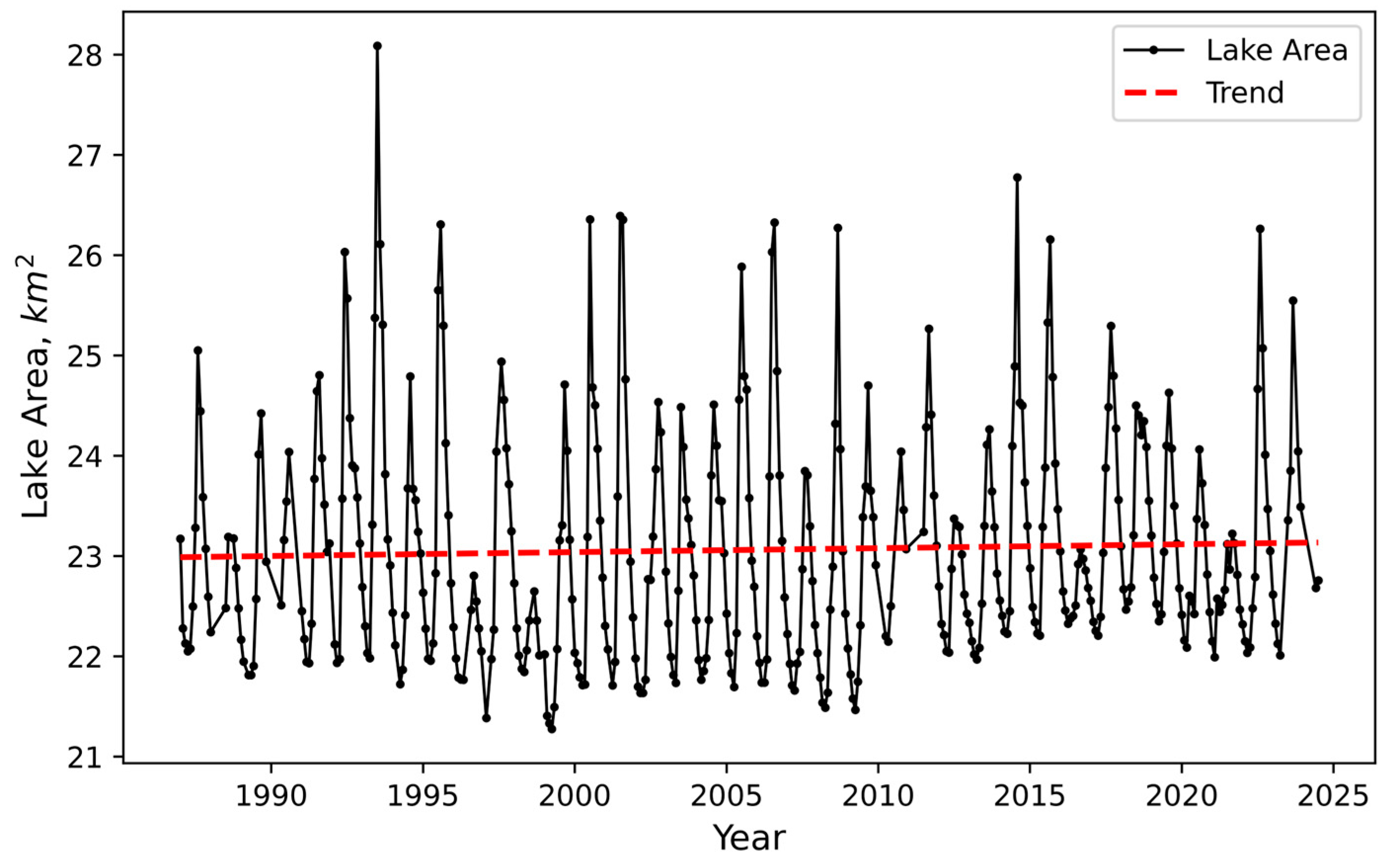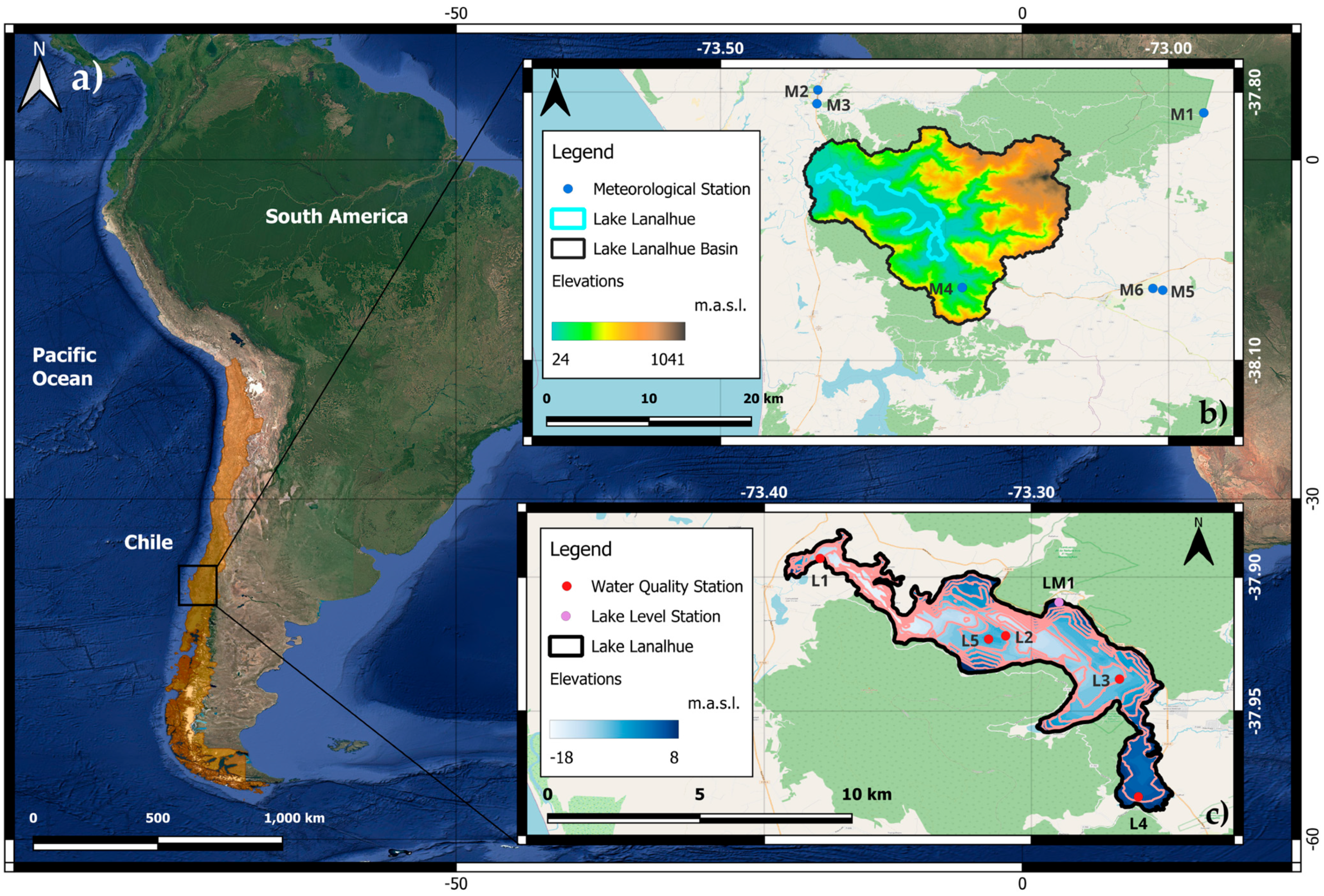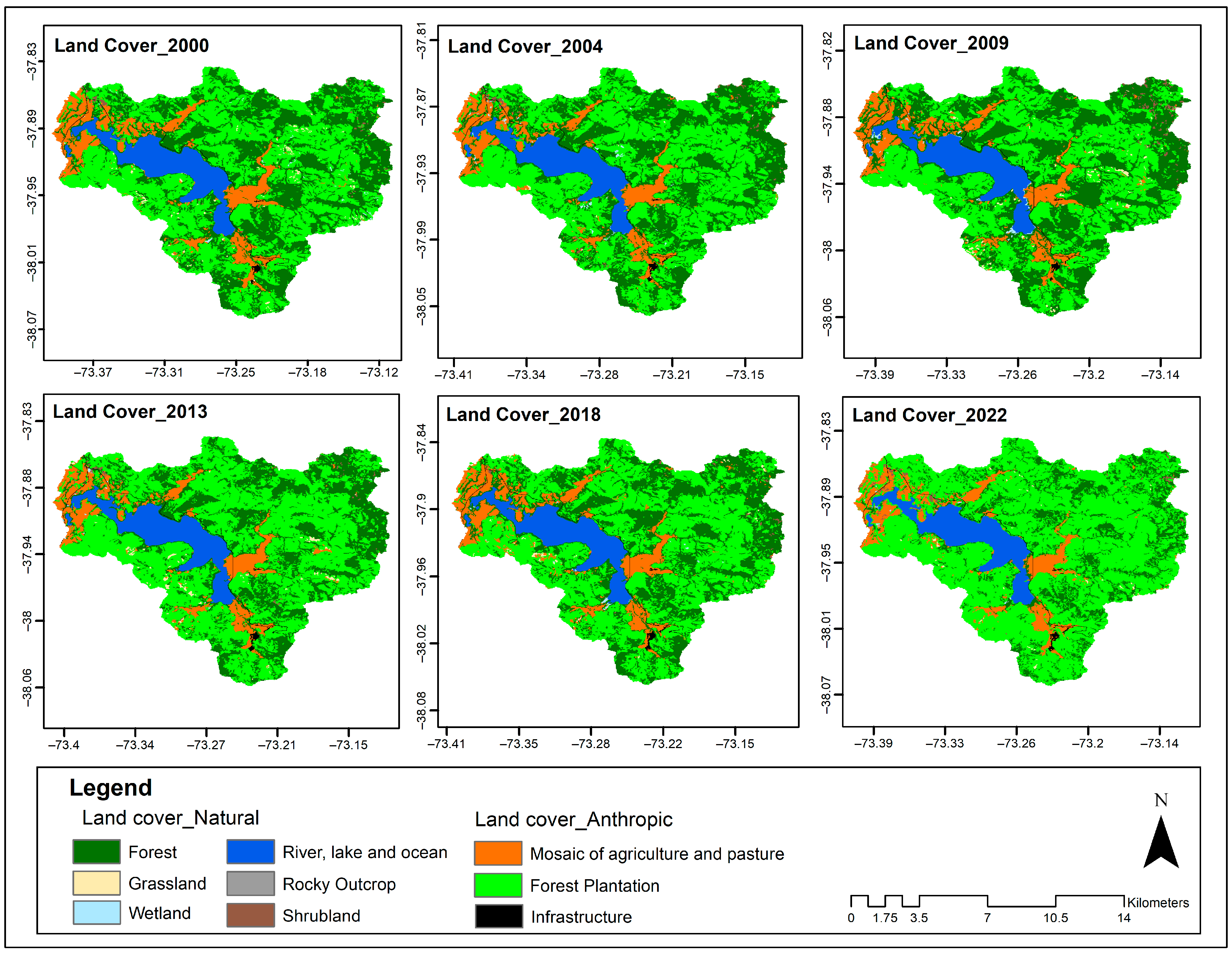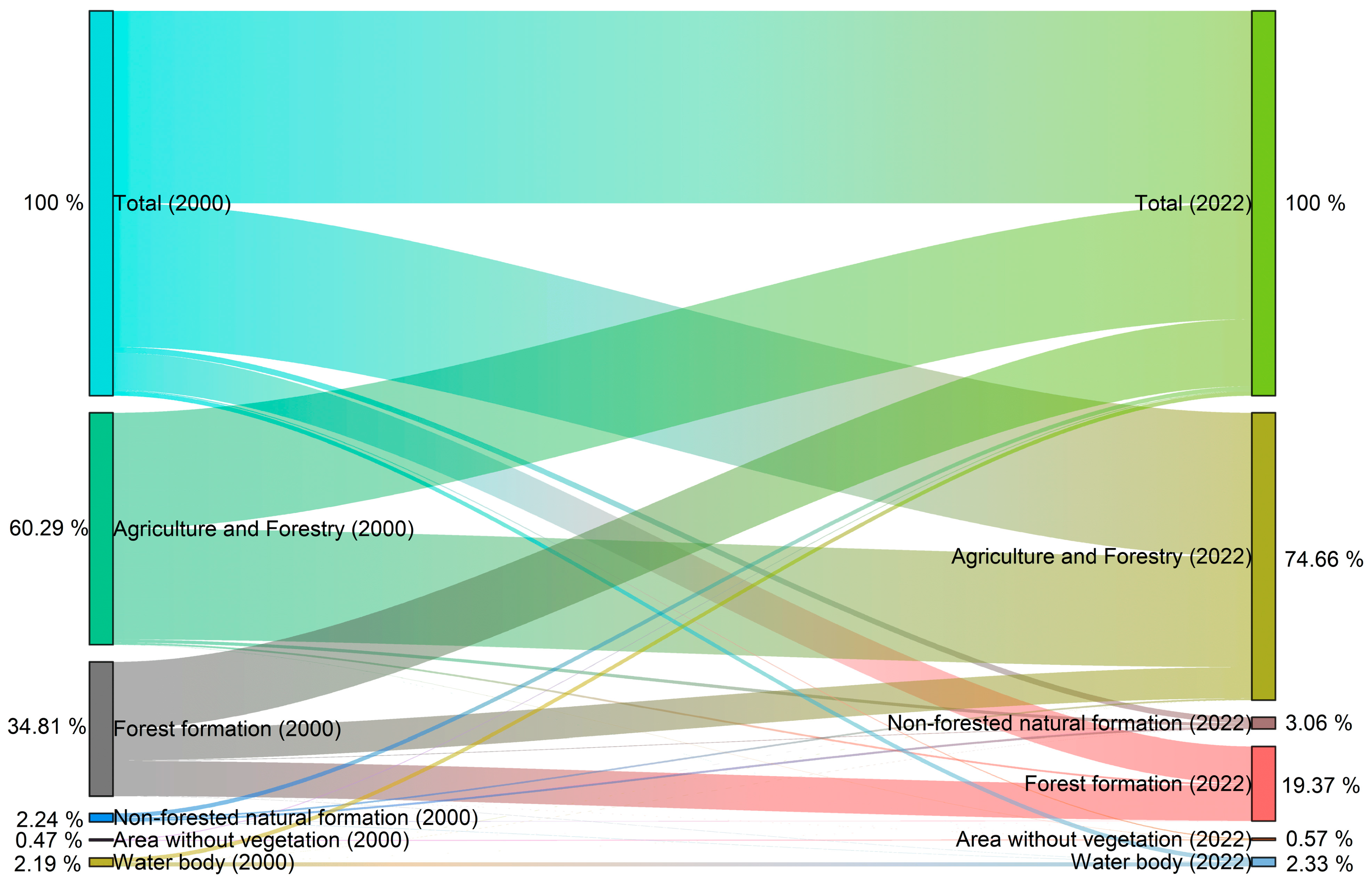Spatio-Temporal Dynamics of the Lanalhue Lake Basin in South-Central Chile
Abstract
1. Introduction
2. Materials and Methods
2.1. Lake Lanalhue Characteristics
2.1.1. Land Cover
2.2. In Situ and Meteorological Data
2.3. Radar Altimetry Data
Water Level from Altimetry
2.4. Statistical Analysis
2.4.1. Nash–Sutcliffe Efficiency (NSE)
2.4.2. Kling–Gupta Efficiency (KGE)
2.4.3. Index of Agreement (d)
2.5. Calculation of the Surface Area and Volume of the Lake
3. Results
3.1. Water Quality Parameter
3.2. Meteorological Conditions
3.3. Land Cover Evolution
3.4. Altimetry-Based Time Series of Water Levels


3.5. Correlation Matrix
3.6. Behavior of Phosporous
4. Discussion
5. Conclusions
Author Contributions
Funding
Data Availability Statement
Acknowledgments
Conflicts of Interest
References
- Hei, P.; Yang, T.; Huang, L.; Liu, Y.; Yang, J.; Shang, Y.; Feng, L.; Huang, G. Unraveling Eutrophication Controversies: Innovative Strategies and Holistic Perspectives. Crit. Rev. Environ. Sci. Technol. 2024, 55, 147–168. [Google Scholar] [CrossRef]
- Suresh, K.; Tang, T.; Van Vliet, M.T.H.; Bierkens, M.F.P.; Strokal, M.; Sorger-Domenigg, F.; Wada, Y. Recent Advancement in Water Quality Indicators for Eutrophication in Global Freshwater Lakes. Environ. Res. Lett. 2023, 18, 063004. [Google Scholar] [CrossRef]
- Li, M.; Dong, J.; Zhang, Y.; Yang, H.; Van Zwieten, L.; Lu, H.; Alshameri, A.; Zhan, Z.; Chen, X.; Jiang, X.; et al. A Critical Review of Methods for Analyzing Freshwater Eutrophication. Water 2021, 13, 225. [Google Scholar] [CrossRef]
- Bănăduc, D.; Simić, V.; Cianfaglione, K.; Barinova, S.; Afanasyev, S.; Öktener, A.; McCall, G.; Simić, S.; Curtean-Bănăduc, A. Freshwater as a Sustainable Resource and Generator of Secondary Resources in the 21st Century: Stressors, Threats, Risks, Management and Protection Strategies, and Conservation Approaches. Int. J. Environ. Res. Public. Health 2022, 19, 16570. [Google Scholar] [CrossRef] [PubMed]
- Ahmed, S.F.; Kumar, P.S.; Kabir, M.; Zuhara, F.T.; Mehjabin, A.; Tasannum, N.; Hoang, A.T.; Kabir, Z.; Mofijur, M. Threats, Challenges and Sustainable Conservation Strategies for Freshwater Biodiversity. Environ. Res. 2022, 214, 113808. [Google Scholar] [CrossRef]
- Sun, Q.; Yan, Z.; Wang, J.; Chen, J.A.; Li, X.; Shi, W.; Liu, J.; Li, S.L. Evaluating Impacts of Climate and Management on Reservoir Water Quality Using Environmental Fluid Dynamics Code. Sci. Total Environ. 2024, 947, 174608. [Google Scholar] [CrossRef]
- Neale, P.J.; Williamson, C.E.; Banaszak, A.T.; Häder, D.P.; Hylander, S.; Ossola, R.; Rose, K.C.; Wängberg, S.; Zepp, R. The Response of Aquatic Ecosystems to the Interactive Effects of Stratospheric Ozone Depletion, UV Radiation, and Climate Change. Photochem. Photobiol. Sci. 2023, 22, 1093–1127. [Google Scholar] [CrossRef]
- Lakshmikandan, M.; Li, M.; Pan, B. Cyanobacterial Blooms in Environmental Water: Causes and Solutions. Curr. Pollut. Rep. 2024, 10, 606–627. [Google Scholar] [CrossRef]
- Zhang, Y.; Shen, J.; He, L.; Feng, J.; Chi, L.; Wang, X. Challenge to Lake Ecosystems: Changes in Thermal Structure Triggered by Climate Change. Water 2024, 16, 888. [Google Scholar] [CrossRef]
- Singh, P.K.; Kumar, U.; Kumar, I.; Dwivedi, A.; Singh, P.; Mishra, S.; Seth, C.S.; Sharma, R.K. Critical Review on Toxic Contaminants in Surface Water Ecosystem: Sources, Monitoring, and Its Impact on Human Health. Environ. Sci. Pollut. Res. 2024, 31, 56428–56462. [Google Scholar] [CrossRef]
- Carey, C.C.; Woelmer, W.M.; Lofton, M.E.; Figueiredo, R.J.; Bookout, B.J.; Corrigan, R.S.; Daneshmand, V.; Hounshell, A.G.; Howard, D.W.; Lewis, A.S.L.; et al. Advancing Lake and Reservoir Water Quality Management with Near-Term, Iterative Ecological Forecasting. Inland. Waters 2022, 12, 107–120. [Google Scholar] [CrossRef]
- Papa, F.; Crétaux, J.F.; Grippa, M.; Robert, E.; Trigg, M.; Tshimanga, R.M.; Kitambo, B.; Paris, A.; Carr, A.; Fleischmann, A.S.; et al. Water Resources in Africa under Global Change: Monitoring Surface Waters from Space. Surv. Geophys. 2023, 44, 43–93. [Google Scholar] [CrossRef] [PubMed]
- Oleksy, I.A.; Jones, S.E.; Solomon, C.T. Hydrologic Setting Dictates the Sensitivity of Ecosystem Metabolism to Climate Variability in Lakes. Ecosystems 2022, 25, 1328–1345. [Google Scholar] [CrossRef]
- Kuhlmann Andersen, T.; Nielsen, A.; Jeppesen, E.; Hu, F.; Bolding, K.; Liu, Z.; Søndergaard, M.; Johansson, L.S.; Trolle, D.; Andersen, C.; et al. Predicting Ecosystem State Changes in Shallow Lakes Using an Aquatic Ecosystem Model: Lake Hinge, Denmark, an Example. Ecol. Appl. 2020, 30, e02160. [Google Scholar] [CrossRef]
- Yan, Z.; Feng, C.; Jin, X.; Qiao, Y.; Wang, J.; Huang, N.; Bai, Y. Unbalanced Pollution and Ecological Risk of Organophosphate Esters in Chinese Surface Water and Land Use Under Multiple Driving Factors. Rev. Environ. Contam. Toxicol. 2023, 261, 18. [Google Scholar] [CrossRef]
- Njagi, D.M.; Routh, J.; Odhiambo, M.; Luo, C.; Basapuram, L.G.; Olago, D.; Klump, V.; Stager, C. A Century of Human-Induced Environmental Changes and the Combined Roles of Nutrients and Land Use in Lake Victoria Catchment on Eutrophication. Sci. Total Environ. 2022, 835, 155425. [Google Scholar] [CrossRef]
- Lukhele, T.; Msagati, T.A.M. Eutrophication of Inland Surface Waters in South Africa: An Overview. Int. J. Environ. Res. 2024, 18, 27. [Google Scholar] [CrossRef]
- Alaniz, A.J.; Abarzúa, A.M.; Martel-Cea, A.; Jarpa, L.; Hernández, M.; Aquino-López, M.A.; Smith-Ramírez, C. Linking Sedimentological and Spatial Analysis to Assess the Impact of the Forestry Industry on Soil Loss: The Case of Lanalhue Basin, Chile. Catena 2021, 207, 105660. [Google Scholar] [CrossRef]
- Tang, F.; Li, J.; Ma, X.; Li, Y.; Yang, H.; Huang, C.; Huang, T. Temporal Patterns and Driving Factors of Sediment Carbon, Nitrogen, and Phosphorus Stoichiometry in a Eutrophication Plateau Lake. Sci. Total Environ. 2024, 915, 170016. [Google Scholar] [CrossRef]
- Sánchez Valdivia, A.; De Stefano, L.G.; Ferraro, G.; Gianello, D.; Ferral, A.; Dogliotti, A.I.; Reissig, M.; Gerea, M.; Queimaliños, C.; Pérez, G.L. Characterizing Chromophoric Dissolved Organic Matter Spatio-Temporal Variability in North Andean Patagonian Lakes Using Remote Sensing Information and Environmental Analysis. Remote Sens. 2024, 16, 4063. [Google Scholar] [CrossRef]
- Barraza-Moraga, F.; Alcayaga, H.; Pizarro, A.; Félez-Bernal, J.; Urrutia, R. Estimation of Chlorophyll-a Concentrations in Lanalhue Lake Using Sentinel-2 MSI Satellite Images. Remote Sens. 2022, 14, 5647. [Google Scholar] [CrossRef]
- Heslop, E.E.; Sánchez-Román, A.; Pascual, A.; Rodríguez, D.; Reeve, K.A.; Faugère, Y.; Raynal, M. Sentinel-3A Views Ocean Variability More Accurately at Finer Resolution. Geophys. Res. Lett. 2017, 44, 12367–12374. [Google Scholar] [CrossRef]
- Yang, J.; Zhang, J. Validation of Sentinel-3A/3B Satellite Altimetry Wave Heights with Buoy and Jason-3 Data. Sensors 2019, 19, 2914. [Google Scholar] [CrossRef] [PubMed]
- Donlon, C.; Berruti, B.; Buongiorno, A.; Ferreira, M.H.; Féménias, P.; Frerick, J.; Goryl, P.; Klein, U.; Laur, H.; Mavrocordatos, C.; et al. The Global Monitoring for Environment and Security (GMES) Sentinel-3 Mission. Remote Sens. Environ. 2012, 120, 37–57. [Google Scholar] [CrossRef]
- Roy, Y.L.; Deschaux-Beaume, M.; Mavrocordatos, C.; Aguirre, M.; Heliere, F. SRAL SAR Radar Altimeter for Sentinel-3 Mission. In Proceedings of the 2007 IEEE International Geoscience and Remote Sensing Symposium, Barcelona, Spain, 23–28 July 2007; pp. 219–222. [Google Scholar]
- Halicki, M.; Niedzielski, T. The Accuracy of the Sentinel-3A Altimetry over Polish Rivers. J. Hydrol. 2022, 606, 127355. [Google Scholar] [CrossRef]
- Benveniste, J. Radar Altimetry: Past, Present and Future. In Coastal Altimetry; Springer: Berlin/Heidelberg, Germany, 2011; pp. 1–17. ISBN 9783642127953. [Google Scholar]
- Biancamaria, S.; Frappart, F.; Leleu, A.S.; Marieu, V.; Blumstein, D.; Desjonquères, J.D.; Boy, F.; Sottolichio, A.; Valle-Levinson, A. Satellite Radar Altimetry Water Elevations Performance over a 200 m Wide River: Evaluation over the Garonne River. Adv. Space Res. 2017, 59, 128–146. [Google Scholar] [CrossRef]
- Pham-Duc, B.; Frappart, F.; Tran-Anh, Q.; Si, S.T.; Phan, H.; Quoc, S.N.; Le, A.P.; Viet, B. Do Monitoring Lake Volume Variation from Space Using Satellite Observations—A Case Study in Thac Mo Reservoir (Vietnam). Remote Sens. 2022, 14, 4023. [Google Scholar] [CrossRef]
- Oularé, S.; Sokeng, V.C.J.; Kouamé, K.F.; Komenan, C.A.K.; Danumah, J.H.; Mertens, B.; Akpa, Y.L.; Catry, T.; Pillot, B. Contribution of Sentinel-3A Radar Altimetry Data to the Study of the Water Level Variations in Lake Buyo (West of Côte d’Ivoire). Remote Sens. 2022, 14, 5602. [Google Scholar] [CrossRef]
- Frappart, F.; Blarel, F.; Fayad, I.; Bergé-Nguyen, M.; Crétaux, J.F.; Shu, S.; Schregenberger, J.; Baghdadi, N. Evaluation of the Performances of Radar and Lidar Altimetry Missions for Water Level Retrievals in Mountainous Environment: The Case of the Swiss Lakes. Remote Sens. 2021, 13, 2196. [Google Scholar] [CrossRef]
- Nash, J.E.; Sutcliffe, J. V River Flow Forecasting through Conceptual Models Part I—A Discussion of Principles. J. Hydrol. 1970, 10, 282–290. [Google Scholar] [CrossRef]
- Guse, B.; Pfannerstill, M.; Gafurov, A.; Kiesel, J.; Lehr, C.; Fohrer, N. Identifying the Connective Strength between Model Parameters and Performance Criteria. Hydrol. Earth Syst. Sci. 2017, 21, 5663–5679. [Google Scholar] [CrossRef]
- Medina, Y.; Muñoz, E. Estimation of Annual Maximum and Minimum Flow Trends in a Data-Scarce Basin. Case Study of the Allipen River Watershed, Chile. Water 2020, 12, 162. [Google Scholar] [CrossRef]
- Moriasi, D.N.; Arnold, J.G.; Liew, M.W.V.; Bingner, R.L.; Harmel, R.D.; Veith, T.L. Model Evaluation Guidelines For Systematic Quantification of Accuracy in Watershed Simulations. Trans. ASABE 2007, 50, 885–900. [Google Scholar] [CrossRef]
- Gupta, H.V.; Kling, H.; Yilmaz, K.K.; Martinez, G.F. Decomposition of the Mean Squared Error and NSE Performance Criteria: Implications for Improving Hydrological Modelling. J. Hydrol. 2009, 377, 80–91. [Google Scholar] [CrossRef]
- Patil, S.D.; Stieglitz, M. Comparing Spatial and Temporal Transferability of Hydrological Model Parameters. J. Hydrol. 2015, 525, 409–417. [Google Scholar] [CrossRef]
- Willmott, C.J.; Robeson, S.M.; Matsuura, K. A Refined Index of Model Performance. Int. J. Climatol. 2012, 32, 2088–2094. [Google Scholar] [CrossRef]
- Fuentes-Aguilera, P.; Rodríguez-López, L.; Bourrel, L.; Frappart, F. Recovery of Time Series of Water Volume in Lake Ranco (South Chile) through Satellite Altimetry and Its Relationship with Climatic Phenomena. Water 2024, 16, 1997. [Google Scholar] [CrossRef]
- Dga Evaluación de la Condición Trófica de la Red de Control de Lagos de la dga; Water Directorate of Chile: Santiago, Chile, 2014.
- Rodríguez-López, L.; González-Rodríguez, L.; Duran-Llacer, I.; García, W.; Cardenas, R.; Urrutia, R. Assessment of the Diffuse Attenuation Coefficient of Photosynthetically Active Radiation in a Chilean Lake. Remote Sens. 2022, 14, 4568. [Google Scholar] [CrossRef]
- Rodríguez-López, L.; Duran-Llacer, I.; Bravo Alvarez, L.; Lami, A.; Urrutia, R. Recovery of Water Quality and Detection of Algal Blooms in Lake Villarrica through Landsat Satellite Images and Monitoring Data. Remote Sens. 2023, 15, 1929. [Google Scholar] [CrossRef]
- Rodríguez-López, L.; Alvarez, D.; Bustos Usta, D.; Duran-Llacer, I.; Bravo Alvarez, L.; Fagel, N.; Bourrel, L.; Frappart, F.; Urrutia, R. Chlorophyll-a Detection Algorithms at Different Depths Using In Situ, Meteorological, and Remote Sensing Data in a Chilean Lake. Remote Sens. 2024, 16, 647. [Google Scholar] [CrossRef]
- Rodríguez-López, L.; Bravo Alvarez, L.; Duran-Llacer, I.; Ruíz-Guirola, D.E.; Montejo-Sánchez, S.; Martínez-Retureta, R.; López-Morales, E.; Bourrel, L.; Frappart, F.; Urrutia, R. Leveraging Machine Learning and Remote Sensing for Water Quality Analysis in Lake Ranco, Southern Chile. Remote Sens. 2024, 16, 3401. [Google Scholar] [CrossRef]
- Rodríguez-López, L.; Duran-Llacer, I.; González-Rodríguez, L.; Cardenas, R.; Urrutia, R. Retrieving water turbidity in araucanian lakes (South-central chile) based on multispectral landsat imagery. Remote Sens. 2021, 13, 3133. [Google Scholar] [CrossRef]
- Yépez, S.; Velásquez, G.; Torres, D.; Saavedra-Passache, R.; Pincheira, M.; Cid, H.; Rodríguez-López, L.; Contreras, A.; Frappart, F.; Cristóbal, J.; et al. Spatiotemporal Variations in Biophysical Water Quality Parameters: An Integrated In Situ and Remote Sensing Analysis of an Urban Lake in Chile. Remote Sens. 2024, 16, 427. [Google Scholar] [CrossRef]
- Rodríguez-López, L.; Lami, A.; El Ouahabi, M.; Fagel, N.; Álvarez, D.; González-Rodríguez, L.; Schmidt, S.; Urrutia, R. Fossil Pigments and Environmental Conditions in the Oligotrophic Laja Lake in the Chilean Andes. Anthropocene 2022, 37, 100321. [Google Scholar] [CrossRef]







| Summer | Autumn | Winter | Spring | ||||||||||||||||||
|---|---|---|---|---|---|---|---|---|---|---|---|---|---|---|---|---|---|---|---|---|---|
| L1 | L2 | L3 | L4 | L5 | L1 | L2 | L3 | L4 | L5 | L1 | L2 | L3 | L4 | L5 | L1 | L2 | L3 | L4 | L5 | ||
| SD (m) | Av | 3.8 | 3.2 | 3.0 | 3.2 | 3.2 | 2.5 | 2.5 | 2.4 | 2.1 | 2.7 | 2.9 | 2.9 | 2.2 | 1.4 | 2.2 | 2.5 | 2.5 | 2.4 | 2.1 | 2.7 |
| Max | 6.5 | 5.0 | 4.5 | 5.0 | 4.8 | 4.0 | 4.0 | 3.6 | 17 | 4.5 | 8.5 | 8.5 | 4.7 | 3.5 | 5.0 | 4.0 | 4.0 | 3.6 | 17 | 4.5 | |
| Min | 3.0 | 0.0 | 0.0 | 0.0 | 0.0 | 0.0 | 0.0 | 0.0 | 0.0 | 0.0 | 0.0 | 0.0 | 0.0 | 0.0 | 0.0 | 0.0 | 0.0 | 0.0 | 0.0 | 0.0 | |
| DV | 1.4 | 1.2 | 1.1 | 1.2 | 1.1 | 1.4 | 1.4 | 1.2 | 3.9 | 1.4 | 1.8 | 1.8 | 1.3 | 0.9 | 1.2 | 1.4 | 1.4 | 1.2 | 3.9 | 1.4 | |
| CV (%) | 38 | 36 | 37 | 36 | 35 | 56 | 56 | 48 | 18 | 52 | 62 | 62 | 58 | 63 | 53 | 56 | 56 | 49 | 185 | 52 | |
| N | 6 | 15 | 15 | 15 | 15 | 20 | 20 | 21 | 20 | 20 | 8 | 19 | 19 | 22 | 19 | 20 | 20 | 21 | 20 | 20 | |
| T (°C) | Av | 22 | 22 | 22 | 22 | 21 | 16 | 16 | 15 | 14 | 16 | 11 | 11 | 11 | 11 | 11 | 16 | 15 | 15 | 14 | 16 |
| Max | 23 | 23 | 23 | 23 | 23 | 19 | 19 | 20 | 19 | 19 | 13 | 13 | 13 | 13 | 13 | 19 | 19 | 20 | 19 | 19 | |
| Min | 21 | 20 | 21 | 21 | 20 | 12 | 12 | 12 | 12 | 12 | 9.2 | 9.2 | 9.3 | 8.4 | 9.3 | 12 | 12 | 12 | 12 | 12 | |
| DV | 0.6 | 1.0 | 1.0 | 1.0 | 0.8 | 2.1 | 2.1 | 2.3 | 2.0 | 2.2 | 0.8 | 0.8 | 0.9 | 1.0 | 0.8 | 2.1 | 2.1 | 2.3 | 2 | 2.2 | |
| CV (%) | 2.6 | 4.4 | 4.3 | 4.3 | 3.6 | 14 | 14 | 15 | 14 | 14 | 7.5 | 7.5 | 7.8 | 9.4 | 7.0 | 14 | 14 | 15 | 14 | 14 | |
| N | 7 | 15 | 15 | 15 | 14 | 20 | 20 | 21 | 20 | 20 | 19 | 19 | 19 | 22 | 19 | 20 | 20 | 21 | 20 | 20 | |
| NTU | Av | 2.2 | 1.7 | 4.6 | 4.6 | 1.6 | 3.7 | 3.7 | 3.4 | 11 | 4.0 | 4.3 | 4.3 | 6.2 | 8.2 | 6.5 | 3.9 | 3.9 | 3.5 | 5 | 2.1 |
| Max | 2.2 | 4.1 | 20 | 20 | 4.6 | 7.0 | 7.0 | 7.2 | 40 | 7.0 | 15 | 15 | 16 | 21 | 14 | 4.8 | 4.8 | 5.8 | 14 | 4.3 | |
| Min | 2.2 | 0.5 | 0.3 | 0.3 | 0.2 | 0.9 | 0.9 | 0.4 | 3.9 | 2.8 | 0.2 | 0.2 | 0.2 | 1.3 | 0.3 | 2.7 | 2.7 | 1.2 | 1 | 0.2 | |
| DV | 0.0 | 1.0 | 7.5 | 7.5 | 1.1 | 1.7 | 1.7 | 1.9 | 7.8 | 1.4 | 3.5 | 3.5 | 4.3 | 6.1 | 3.8 | 0.9 | 0.9 | 1.7 | 4 | 1.6 | |
| CV (%) | 0.0 | 63 | 162 | 162 | 73 | 47 | 47 | 55 | 69 | 35 | 81 | 80 | 70 | 74 | 59 | 23 | 23 | 49 | 93 | 76 | |
| N | 8 | 15 | 6 | 6 | 15 | 20 | 20 | 21 | 20 | 20 | 19 | 19 | 19 | 22 | 19 | 17 | 17 | 17 | 17 | 17 | |
| TN (µg/L) | Av | 0.2 | 188 | 30 | 265 | 265 | 374 | 376 | 366 | 488 | 354 | 343 | 343 | 315 | 349 | 484 | 216 | 216 | 184 | 315 | 255 |
| Max | 0.2 | 227 | 402 | 271 | 271 | 380 | 380 | 451 | 77 | 370 | 390 | 390 | 354 | 435 | 559 | 245 | 245 | 237 | 359 | 318 | |
| Min | 0.2 | 170 | 203 | 262 | 262 | 348 | 348 | 110 | 123 | 255 | 199 | 199 | 222 | 0.0 | 230 | 129 | 129 | 145 | 194 | 209 | |
| DV | 0.0 | 27 | 100 | 4.2 | 4.2 | 7.8 | 7.8 | 147 | 193 | 24 | 68 | 68 | 54 | 169 | 113 | 52 | 52 | 26 | 72 | 37 | |
| CV (%) | 0.0 | 14 | 34 | 1.6 | 1.6 | 2.1 | 2.1 | 40 | 40 | 6.8 | 20 | 19 | 17 | 48 | 23 | 24 | 23 | 14 | 23 | 14 | |
| N | 9 | 15 | 3 | 15 | 15 | 20 | 20 | 21 | 20 | 20 | 19 | 19 | 19 | 22 | 19 | 17 | 17 | 17 | 17 | 17 | |
| Chl-a (µg/L) | Av | 3.1 | 2.0 | 3.4 | 2.0 | 2.0 | 4.7 | 4.7 | 5.2 | 9.6 | 4.7 | 1.2 | 1.7 | 1.3 | 0.6 | 0.9 | 2.6 | 2.6 | 3.0 | 6 | 2.4 |
| Max | 11 | 7.7 | 9.8 | 5.6 | 5.6 | 13 | 13 | 15 | 17 | 9.8 | 1.4 | 2.9 | 1.7 | 1.3 | 1.4 | 7.5 | 7.5 | 8.1 | 15 | 13 | |
| Min | 1.5 | 0.3 | 0.8 | 0.7 | 0.7 | 1.5 | 1.5 | 1.8 | 2.4 | 1.9 | 0.4 | 1.4 | 0.6 | 0.2 | 0.4 | 0.9 | 0.9 | 0.8 | 3 | 0.5 | |
| DV | 4.0 | 1.8 | 2.9 | 1.2 | 1.2 | 2.8 | 2.8 | 3.3 | 4.2 | 2.3 | 0.4 | 0.5 | 0.4 | 0.4 | 0.5 | 1.7 | 1.7 | 2.2 | 4 | 3.1 | |
| CV (%) | 129 | 92 | 84 | 57 | 58 | 61 | 61 | 62 | 44 | 48 | 32 | 29 | 32 | 69 | 52 | 67 | 67 | 73 | 59 | 126 | |
| N | 10 | 15 | 11 | 15 | 15 | 20 | 20 | 21 | 20 | 20 | 20 | 19 | 19 | 22 | 19 | 17 | 17 | 17 | 16 | 17 | |
| TP (µg/L) | Av | 0.01 | 15 | 17 | 18 | 9.5 | 12 | 12 | 1 | 21 | 10 | 10 | 10 | 13 | 21 | 9.9 | 19 | 18 | 18 | 28 | 19.1 |
| Max | 0.01 | 30 | 84 | 85 | 3 | 45 | 45 | 21 | 44 | 46 | 22 | 21 | 24 | 29 | 21 | 200 | 200 | 200 | 200 | 200 | |
| Min | 0.01 | 0.0 | 0.0 | 0.0 | 0.0 | 2.8 | 2.8 | 4.4 | 6.3 | 2.4 | 2.5 | 2.5 | 5.0 | 0.0 | 2.6 | 2.5 | 2.5 | 2.5 | 8.4 | 4.8 | |
| DV | 0.0 | 11.5 | 24 | 2 | 7.3 | 9.0 | 9.0 | 5.6 | 14 | 10 | 6.4 | 6.4 | 5.8 | 9.2 | 6.9 | 46 | 47 | 46 | 46 | 47 | |
| CV (%) | 0.0 | 75 | 137 | 137 | 77 | 73 | 73 | 53 | 67 | 102 | 61 | 61 | 43 | 44 | 69 | 253 | 253 | 252 | 162 | 244 | |
| N | 11 | 15 | 11 | 11 | 15 | 20 | 20 | 21 | 20 | 20 | 19 | 19 | 19 | 22 | 19 | 17 | 17 | 17 | 17 | 17 | |
| LAND COVER | CLASSE (ha) | 2000 | 2004 | 2009 | 2013 | 2018 | 2022 |
|---|---|---|---|---|---|---|---|
| NATURAL | Forest | 37,902.29 | 32,007.11 | 33,469.14 | 30,117.12 | 33,405.48 | 21,096.52 |
| Grassland | 148.01 | 204.59 | 214.50 | 154.59 | 221.67 | 141.22 | |
| Wetland | 276.24 | 152.48 | 1088.08 | 199.78 | 115.99 | 459.99 | |
| River, lake and ocean | 2389.78 | 2623.45 | 3796.37 | 3218.78 | 3251.73 | 2540.36 | |
| Rocky outcrop | 1679.79 | 830.00 | 267.78 | 71.86 | 382.13 | 1134.48 | |
| Shrubland | 334.78 | 406.33 | 905.60 | 1126.45 | 574.80 | 1595.85 | |
| ANTHROPIC | Mosaic of agriculture and pasture | 28,781.80 | 29,705.09 | 29,571.66 | 25,965.76 | 28,145.41 | 22,599.71 |
| Forest plantation | 36,863.05 | 41,881.32 | 39,017.25 | 46,797.16 | 42,039.18 | 58,695.44 | |
| Infrastructure | 504.32 | 492.89 | 541.16 | 588.44 | 573.17 | 619.53 |
Disclaimer/Publisher’s Note: The statements, opinions and data contained in all publications are solely those of the individual author(s) and contributor(s) and not of MDPI and/or the editor(s). MDPI and/or the editor(s) disclaim responsibility for any injury to people or property resulting from any ideas, methods, instructions or products referred to in the content. |
© 2025 by the authors. Licensee MDPI, Basel, Switzerland. This article is an open access article distributed under the terms and conditions of the Creative Commons Attribution (CC BY) license (https://creativecommons.org/licenses/by/4.0/).
Share and Cite
Rodríguez-López, L.; Fuentes-Aguilera, P.; Bravo Alvarez, L.; Martínez-Retureta, R.; Duran-Llacer, I.; Bourrel, L.; Frappart, F.; Urrutia, R. Spatio-Temporal Dynamics of the Lanalhue Lake Basin in South-Central Chile. Water 2025, 17, 1114. https://doi.org/10.3390/w17081114
Rodríguez-López L, Fuentes-Aguilera P, Bravo Alvarez L, Martínez-Retureta R, Duran-Llacer I, Bourrel L, Frappart F, Urrutia R. Spatio-Temporal Dynamics of the Lanalhue Lake Basin in South-Central Chile. Water. 2025; 17(8):1114. https://doi.org/10.3390/w17081114
Chicago/Turabian StyleRodríguez-López, Lien, Patricio Fuentes-Aguilera, Lisandra Bravo Alvarez, Rebeca Martínez-Retureta, Iongel Duran-Llacer, Luc Bourrel, Frederic Frappart, and Roberto Urrutia. 2025. "Spatio-Temporal Dynamics of the Lanalhue Lake Basin in South-Central Chile" Water 17, no. 8: 1114. https://doi.org/10.3390/w17081114
APA StyleRodríguez-López, L., Fuentes-Aguilera, P., Bravo Alvarez, L., Martínez-Retureta, R., Duran-Llacer, I., Bourrel, L., Frappart, F., & Urrutia, R. (2025). Spatio-Temporal Dynamics of the Lanalhue Lake Basin in South-Central Chile. Water, 17(8), 1114. https://doi.org/10.3390/w17081114









